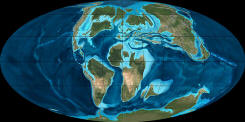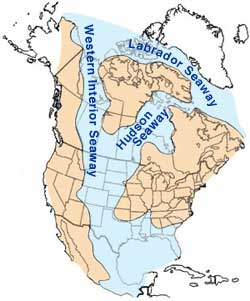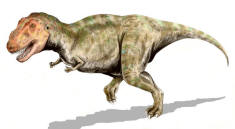Climate
The early part of the Cretaceous showed a cooling trend that had been seen in the last epoch of the Jurassic. There is evidence that snowfalls were common in the higher latitudes and the tropics became wetter than during the Triassic and Jurassic. Glaciation was however restricted to alpine glaciers on some high-latitude mountains, though seasonal snow may have existed farther south.
After the few million years, however, temperatures increased again, and these conditions were almost constant until the end of the period. This trend was due to intense volcanic activity which produced large quantities of carbon dioxide. The development of a number of mantle plumes across the widening mid-ocean ridges further pushed sea levels up, so that large areas of the continental crust were covered with shallow seas. The Tethys Sea connecting the tropical oceans east to west also helped in warming the global climate. Warm-adapted plant fossils are known from localities as far north as Alaska and Greenland, while dinosaur fossils have been found within 15 degrees of the Cretaceous south pole.
A very gentle temperature gradient from the equator to the poles meant weaker global winds, contributing to less upwelling and more stagnant oceans than today. This is evidenced by widespread black shale deposition and frequent anoxic events. Sediment cores show that tropical sea surface temperatures may have briefly been as warm as 42 °C (107 °F), 17 °C (31 °F) warmer than at present, and that they averaged around 37 °C (99 °F). Meanwhile deep ocean temperatures were as much as 15 to 20 °C (27 to 36 °F) higher than today's.
Paleogeography
 |
| Late Cretaceous Geography (Picture Source) |
During the Cretaceous, the late Paleozoic - early Mesozoic supercontinent of Pangaea completed its breakup into present day continents, although their positions were substantially different at the time. As the Atlantic Ocean widened, the convergent-margin orogenies that had begun during the Jurassic continued in the North American Cordillera, as the Nevadan orogeny was followed by the Sevier and Laramide orogenies. The continental map above shows a representation of the continents as they were approximately 100 million years ago (click for larger view).
Though
Gondwana was still
intact in the beginning of the Cretaceous, it broke up as South America, Antarctica and Australia rifted away
from Africa (though India and Madagascar remained
attached to each other); thus, the South Atlantic and Indian Oceans were
newly formed. Such active rifting lifted great undersea mountain chains
along the welts, raising sea levels
worldwide. To the north of Africa the Tethys Sea continued to
narrow. Broad shallow seas advanced across central North America (the
Western Interior Seaway)
and Europe, then receded late in the period, leaving thick marine deposits
sandwiched between coal beds. At the peak
of the Cretaceous transgression,
one-third of Earth's present land area was submerged.
and Madagascar remained
attached to each other); thus, the South Atlantic and Indian Oceans were
newly formed. Such active rifting lifted great undersea mountain chains
along the welts, raising sea levels
worldwide. To the north of Africa the Tethys Sea continued to
narrow. Broad shallow seas advanced across central North America (the
Western Interior Seaway)
and Europe, then receded late in the period, leaving thick marine deposits
sandwiched between coal beds. At the peak
of the Cretaceous transgression,
one-third of Earth's present land area was submerged.
The Cretaceous is justly famous for its chalk; indeed, more chalk formed in the Cretaceous than in any other period in the Phanerozoic. It consists of coccoliths, microscopically small calcite skeletons of coccolithophores, a type of algae that prospered in the Cretaceous seas. Mid-ocean ridge activity—or rather, the circulation of seawater through the enlarged ridges—enriched the oceans in calcium; this made the oceans more saturated, as well as increased the bioavailability of the element for calcareous nanoplankton. These widespread carbonates and other sedimentary deposits make the Cretaceous rock record especially fine. Famous formations from North America include the rich marine fossils of Kansas's Smoky Hill Chalk Member and the terrestrial fauna of the late Cretaceous Hell Creek Formation. Other important Cretaceous exposures occur in Europe (e.g., the Weald) and China (the Yixian Formation). In the area that is now India, massive lava beds called the Deccan Traps were erupted in the very late Cretaceous and early Paleocene.
Geology
The Cretaceous is divided into Early and Late Cretaceous epochs or Lower and Upper Cretaceous series. In older literature the Cretaceous is sometimes divided into three series: Neocomian (lower/early), Gallic (middle) and Senonian (upper/late). A subdivision in eleven stages, all origining from European stratigraphy, is now used worldwide. In many parts of the world, alternative local subdivisions are still in use.
As with other older geologic periods, the rock beds of the Cretaceous are well identified but the exact ages of the system's base is uncertain by a few million years. No great extinction or burst of diversity separates the Cretaceous from the Jurassic. However, the top of the system is sharply defined, being placed at an iridium-rich layer found worldwide that is believed to be associated with the Chicxulub impact crater in Yucatan and the Gulf of Mexico. This layer has been tightly dated at 65.5 Ma.
The high eustatic sea level and warm climate of the Cretaceous meant a large area of the continents was covered by warm shallow seas. The Cretaceous was named for the extensive chalk deposits of this age in Europe, but in many parts of the world, the Cretaceous system consists for a major part of marine limestone, a rock type that is formed under warm, shallow marine circumstances. Due to the high sea level there was extensive accommodation space for sedimentation so that thick deposits could form. Because of the relatively young age and great thickness of the system, Cretaceous rocks crop out in many areas worldwide.
In northwestern Europe, chalk deposits from the Upper Cretaceous are characteristic for the Chalk Group, which forms the white cliffs of Dover on the south coast of England and similar cliffs on the French Normandian coast. The group is found in England, northern France, the low countries, northern Germany, Denmark and in the subsurface of the southern part of the North Sea. Chalk is not easily lithified and the Chalk Group still consists of loose sediments in many places. The group also has other limestones and arenites. Among the fossils it contains are sea urchins, belemnites, ammonites and sea reptiles such as Mosasaurus.
In southern Europe, the Cretaceous is usually a marine system consisting of competent limestone beds or incompetent marls. Because the Alpine mountain chains did not yet exist in the Cretaceous, these deposits formed on the southern edge of the European continental shelf, at the margin of the Tethys Ocean.
Stagnation of deep sea currents in middle Cretaceous times caused anoxic circumstances in the sea water. In many places around the world, dark anoxic shales were formed during this interval. These shales are an important source rock for oil and gas, for example in the subsurface of the North Sea.
Plants
Flowering plants (angiosperms) spread during this period, although they did not become predominant until the Campanian stage near the end of the epoch, approximately 75 Ma. Their spread was aided by the appearance of bees. The first representatives of many leafy trees, including figs, planes and magnolias, appeared in the Cretaceous. At the same time, some earlier Mesozoic gymnosperms like Conifers continued to thrive; pehuéns (Monkey Puzzle trees, Araucaria) and other conifers being notably plentiful and widespread, although other gymnosperm taxa like Bennettitales died out before the end of the period
Terrestrial Fauna
 |
| Tyrannosaurus rex, one of the largest land predators of all time lived during the late Cretaceous. (click picture to enlarge) (Picture Source) |
On land, mammals were a small and still relatively minor component of the fauna. Early marsupial mammals evolved in the Early Cretaceous, with true placentals emerging in the Late Cretaceous period. The fauna was dominated by archosaurian reptiles, especially dinosaurs, which were at their most diverse stage. Pterosaurs were common in the early and middle Cretaceous, but as the Cretaceous proceeded they faced growing competition from the quickly developing role of birds, and by the end of the period only two highly specialized families remained.
The Liaoning lagerstätte (Chaomidianzi formation) in China provides a glimpse of life in the Early Cretaceous, where preserved remains of numerous types of small dinosaurs, birds, and mammals have been found. The coelurosaur dinosaurs found there represent types of the group Maniraptora, which is transitional between dinosaurs and birds, and are notable for the presence of hair-like feathers.
During the Cretaceous, insects began to diversify, and the oldest known ants, termites and some lepidopterans, akin to butterflies and moths, appeared. Aphids, grasshoppers, and gall wasps appeared.
Marine Fauna
In the seas, rays, modern sharks and teleosts (fish) became common. Marine reptiles included ichthyosaurs in the early and middle of the Cretaceous, becoming extinct during the late Cretaceous, plesiosaurs throughout the entire period, and mosasaurs appearing in the Late Cretaceous.
Baculites, an
ammonite genus with a straight shell,
flourished in the seas along with reef-building rudist
clams. The
Hesperornithiformes
were flightless, marine diving birds that swam like
grebes,
and lived in the Early Cretaceous. Globotruncanid
Foraminifera and
echinoderms such as sea urchins and
starfish (sea stars) thrived. The first
radiation of the
diatoms in the
oceans occurred during the Cretaceous; freshwater diatoms did not appear
until the
Miocene.
The Cretaceous was also an important interval in the evolution of
bioerosion, the production of borings and
scrapings in rocks,
hardgrounds and shells.
End of Reading
Return to the Old Earth Ministries Online Earth History Curriculum homepage.
Source: Cretaceous